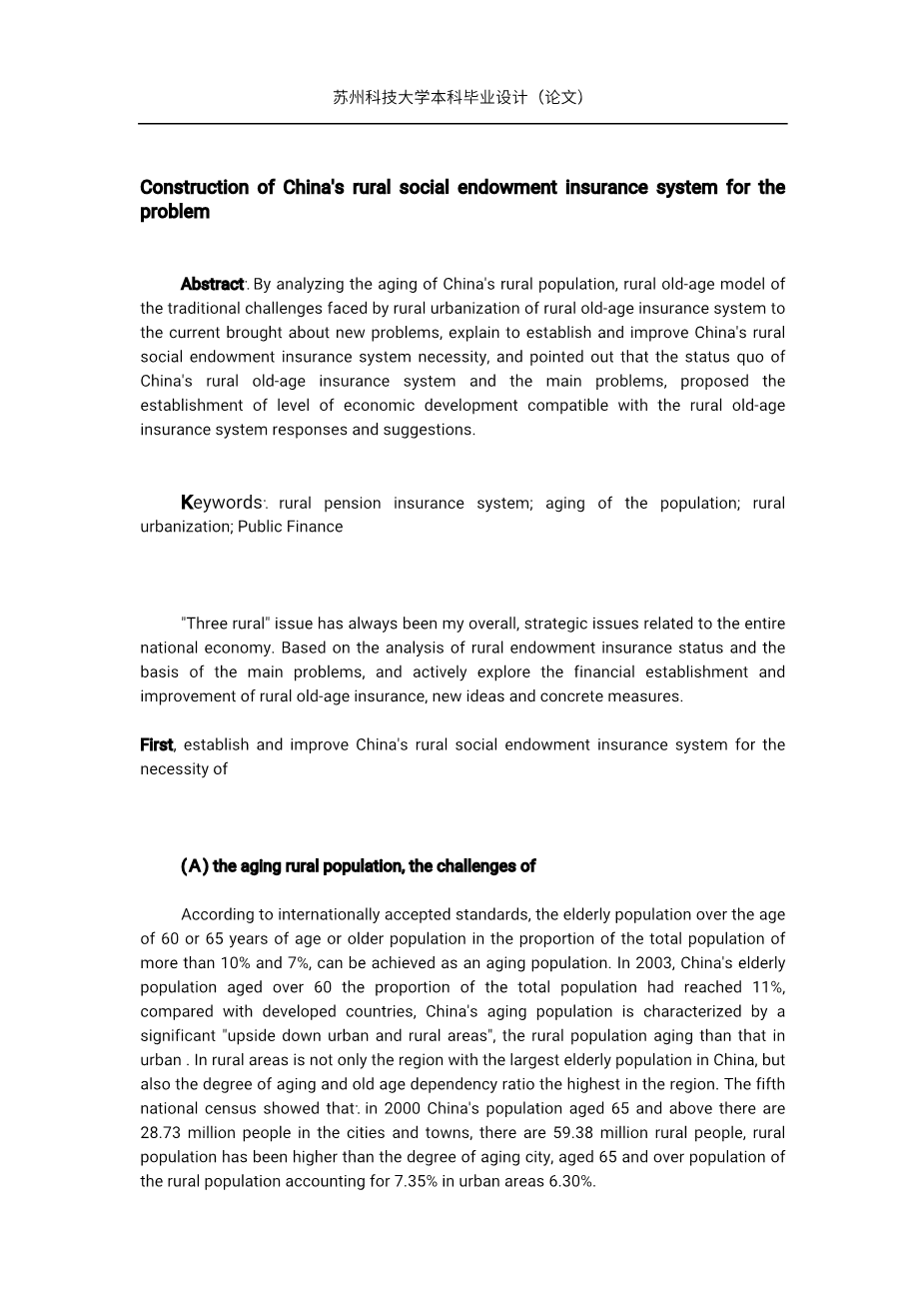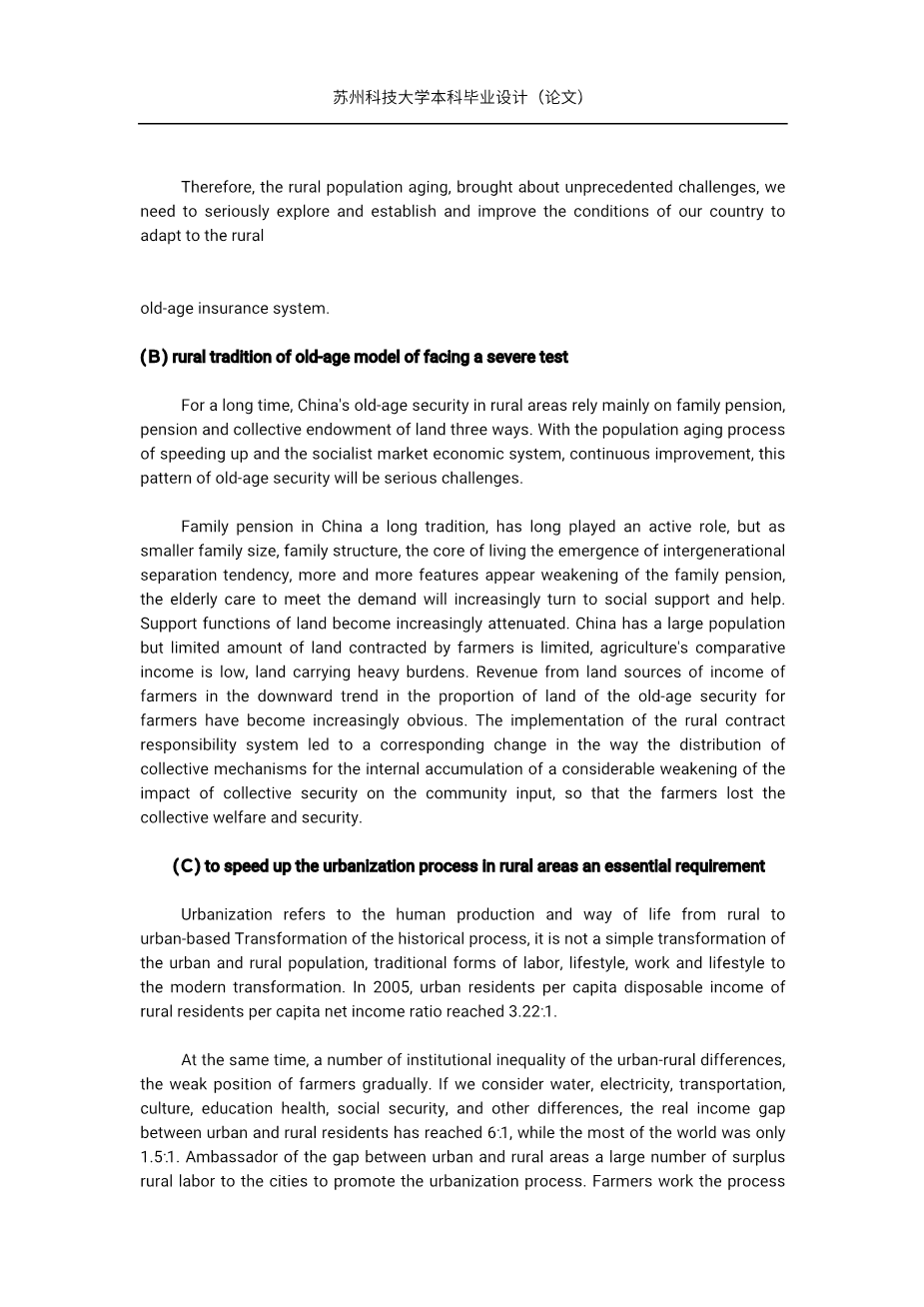Construction of China's rural social endowment insurance system for the problem
Abstract: By analyzing the aging of China's rural population, rural old-age model of the traditional challenges faced by rural urbanization of rural old-age insurance system to the current brought about new problems, explain to establish and improve China's rural social endowment insurance system necessity, and pointed out that the status quo of China's rural old-age insurance system and the main problems, proposed the establishment of level of economic development compatible with the rural old-age insurance system responses and suggestions.
Keywords: rural pension insurance system; aging of the population; rural urbanization; Public Finance
"Three rural" issue has always been my overall, strategic issues related to the entire national economy. Based on the analysis of rural endowment insurance status and the basis of the main problems, and actively explore the financial establishment and improvement of rural old-age insurance, new ideas and concrete measures.
First, establish and improve China's rural social endowment insurance system for the necessity of
(A) the aging rural population, the challenges of
According to internationally accepted standards, the elderly population over the age of 60 or 65 years of age or older population in the proportion of the total population of more than 10% and 7%, can be achieved as an aging population. In 2003, China's elderly population aged over 60 the proportion of the total population had reached 11%, compared with developed countries, China's aging population is characterized by a significant "upside down urban and rural areas", the rural population aging than that in urban . In rural areas is not only the region with the largest elderly population in China, but also the degree of aging and old age dependency ratio the highest in the region. The fifth national census showed that: in 2000 China's population aged 65 and above there are 28.73 million people in the cities and towns, there are 59.38 million rural people, rural population has been higher than the degree of aging city, aged 65 and over population of the rural population accounting for 7.35% in urban areas 6.30%.
Therefore, the rural population aging, brought about unprecedented challenges, we need to seriously explore and establish and improve the conditions of our country to adapt to the rural old-age insurance system.
B) rural tradition of old-age model of facing a severe test
For a long time, China's old-age security in rural areas rely mainly on family pension, pension and collective endowment of land three ways. With the population aging process of speeding up and the socialist market economic system, continuous improvement, this pattern of old-age security will be serious challenges.
Family pension in China a long tradition, has long played an active role, but as smaller family size, family structure, the core of living the emergence of intergenerational separation tendency, more and more features appear weakening of the family pension, the elderly care to meet the demand will increasingly turn to social support and help. Support functions of land become increasingly attenuated. China has a large population but limited amount of land contracted by farmers is limited, agriculture's comparative income is low, land carrying heavy burdens. Revenue from land sources of income of farmers in the downward trend in the proportion of land of the old-age security for farmers have become increasingly obvious. The implementation of the rural contract responsibility system led to a corresponding change in the way the distribution of collective mechanisms for the internal accumulation of a considerable weakening of the impact of collective security on the community input, so that the farmers lost the collective welfare and security.
(C) to speed up the urbanization process in rural areas an essential requirement
Urbanization refers to the human production and way of life from rural to urban-based Transformation of the historical process, it is not a simple transformation of the urban and rural population, traditional forms of labor, lifestyle, work and lifestyle to the modern transformation. In 2005, urban residents per capita disposable income of rural residents per capita net income ratio reached 3.22:1.
At the same time, a number of institutional inequality of the urban-rural differences, the weak position of farmers gradually. If we consider water, electricity, transportation, culture, education health, social security, and other differences, the real income gap between urban and rural residents has reached 6:1, while the most of the world was only 1.5:1. Ambassador of the gap between urban and rural areas a large number of surplus rural labor to the cities to promote the urbanization process. Farmers work the process of urbanization in the special group, they generally do not have access to old-age insurance system in urban areas affordability, and the existing old-age insurance in rural areas did not provide them with the appropriate institutional arrangements.
Second, China's rural old-age insurance and the current status of the main problems
(A) rural endowment insurance system instability, lack of legal protection
The existence of rural social endowment insurance system instability. Throughout the rural social old-age insurance schemes are basically was enacted in 1992 in the Ministry of Civil Affairs, "county-level rural social old-age insurance basic program" based on the formation of some modifications, these methods generally lack the force of law, th
剩余内容已隐藏,支付完成后下载完整资料
英语译文共 16 页,剩余内容已隐藏,支付完成后下载完整资料
资料编号:[484489],资料为PDF文档或Word文档,PDF文档可免费转换为Word
以上是毕业论文外文翻译,课题毕业论文、任务书、文献综述、开题报告、程序设计、图纸设计等资料可联系客服协助查找。




